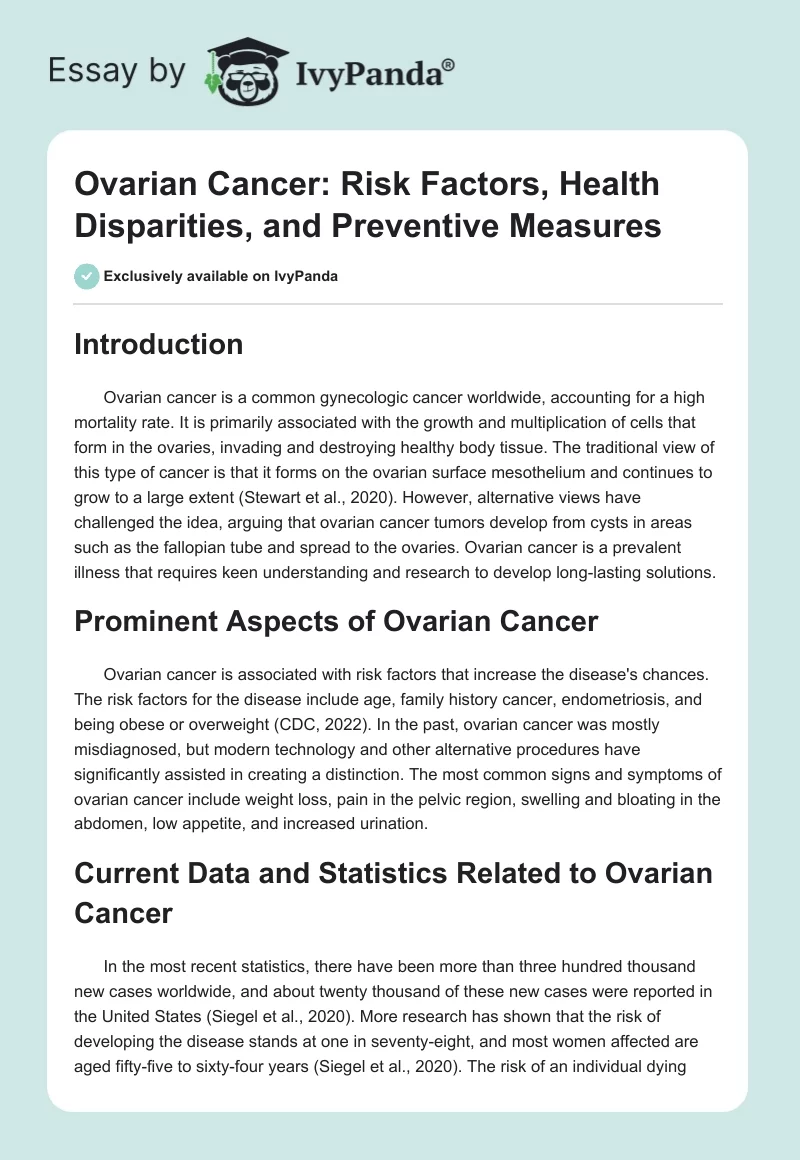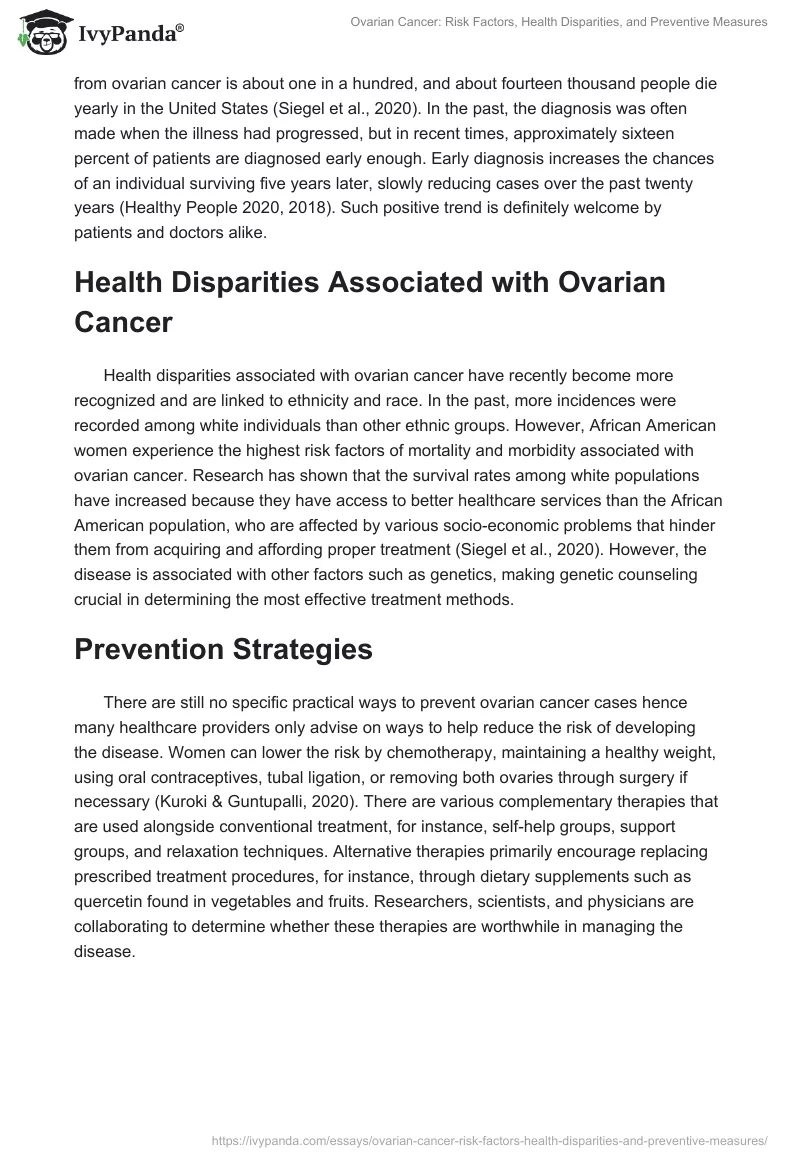- Introduction
- Prominent Aspects of Ovarian Cancer
- Current Data and Statistics Related to Ovarian Cancer
- Health Disparities Associated with Ovarian Cancer
- Prevention Strategies
- Contemporary Research and Clinical Studies on Ovarian Cancer
- Pathophysiologic Effects of Stress and Evidence-Based Interventions
- Conclusion
- References
Introduction
Ovarian cancer is a common gynecologic cancer worldwide, accounting for a high mortality rate. It is primarily associated with the growth and multiplication of cells that form in the ovaries, invading and destroying healthy body tissue. The traditional view of this type of cancer is that it forms on the ovarian surface mesothelium and continues to grow to a large extent (Stewart et al., 2020). However, alternative views have challenged the idea, arguing that ovarian cancer tumors develop from cysts in areas such as the fallopian tube and spread to the ovaries. Ovarian cancer is a prevalent illness that requires keen understanding and research to develop long-lasting solutions.
Prominent Aspects of Ovarian Cancer
Ovarian cancer is associated with risk factors that increase the disease’s chances. The risk factors for the disease include age, family history cancer, endometriosis, and being obese or overweight (CDC, 2022). In the past, ovarian cancer was mostly misdiagnosed, but modern technology and other alternative procedures have significantly assisted in creating a distinction. The most common signs and symptoms of ovarian cancer include weight loss, pain in the pelvic region, swelling and bloating in the abdomen, low appetite, and increased urination.
Current Data and Statistics Related to Ovarian Cancer
In the most recent statistics, there have been more than three hundred thousand new cases worldwide, and about twenty thousand of these new cases were reported in the United States (Siegel et al., 2020). More research has shown that the risk of developing the disease stands at one in seventy-eight, and most women affected are aged fifty-five to sixty-four years (Siegel et al., 2020). The risk of an individual dying from ovarian cancer is about one in a hundred, and about fourteen thousand people die yearly in the United States (Siegel et al., 2020). In the past, the diagnosis was often made when the illness had progressed, but in recent times, approximately sixteen percent of patients are diagnosed early enough. Early diagnosis increases the chances of an individual surviving five years later, slowly reducing cases over the past twenty years (Healthy People 2020, 2018). Such positive trend is definitely welcome by patients and doctors alike.
Health Disparities Associated with Ovarian Cancer
Health disparities associated with ovarian cancer have recently become more recognized and are linked to ethnicity and race. In the past, more incidences were recorded among white individuals than other ethnic groups. However, African American women experience the highest risk factors of mortality and morbidity associated with ovarian cancer. Research has shown that the survival rates among white populations have increased because they have access to better healthcare services than the African American population, who are affected by various socio-economic problems that hinder them from acquiring and affording proper treatment (Siegel et al., 2020). However, the disease is associated with other factors such as genetics, making genetic counseling crucial in determining the most effective treatment methods.
Prevention Strategies
There are still no specific practical ways to prevent ovarian cancer cases hence many healthcare providers only advise on ways to help reduce the risk of developing the disease. Women can lower the risk by chemotherapy, maintaining a healthy weight, using oral contraceptives, tubal ligation, or removing both ovaries through surgery if necessary (Kuroki & Guntupalli, 2020). There are various complementary therapies that are used alongside conventional treatment, for instance, self-help groups, support groups, and relaxation techniques. Alternative therapies primarily encourage replacing prescribed treatment procedures, for instance, through dietary supplements such as quercetin found in vegetables and fruits. Researchers, scientists, and physicians are collaborating to determine whether these therapies are worthwhile in managing the disease.
Contemporary Research and Clinical Studies on Ovarian Cancer
Contemporary research and clinical studies on ovarian cancer are crucial to detect high-risk genes and increase comprehension of the interaction between hormonal and genetic factors to help develop effective ways of preventing this type of cancer (CDC, 2022). In addition, numerous clinical trials frequently determine whether new treatment procedures such as anti-angiogenic are safer than the ones currently available. These studies suggest that soon, there is a higher chance of creating a substantial mode of treatment for ovarian cancer.
Pathophysiologic Effects of Stress and Evidence-Based Interventions
Increased stress levels can result in cancer progression or trigger its reoccurrence. Patients are advised to stay active and seek counseling services to lower stress and depression, which may lead to additional complications (CDC, 2022). Evidence-based stress management interventions that may help include frequent screening, support groups, and stress management training (Healthy People 2020, 2018). It is important that the psychological health of patients is addressed so they can cope with the physical challenges they experience.
In developing countries, governments must improve healthcare conditions and partner with international organizations to acquire necessary medication and equipment. The success of ovarian cancer treatment depends on early diagnosis, which is why evidence-based interventions should include effective population education so that individuals know how to act when they suspect ovarian cancer. Support groups and community resources should be made available to people so that they are well-informed for effective decision-making.
Conclusion
To conclude, ovarian cancer is a prevalent disease that requires intensive research to develop better preventative measures and treatments. People should take a personal initiative to ensure they lead healthy lifestyles and exercise regularly to lower the disease’s chances. Community health programs and awareness campaigns can help spread vital information about the available preventative measures and treatment procedures, and encourage regular screening to detect changes in the body.
References
Centers for Disease Control and Prevention. (2022). Ovarian cancer.Web.
Healthy People 2020. (2018). Ovarian cancer: Screening. Web.
Kuroki, L., & Guntupalli, S. (2020). Treatment of epithelial ovarian cancer. BMJ Healthcare Research, 371. Web.
Siegel, L., Miller, D., & Jemal, A. (2020). Cancer statistics.A Cancer Journal for Clinicians, 70(1), 7-30. Web.
Stewart, C., Ralyea, C., & Lockwood, S. (2020). Ovarian cancer: An integrated review.Seminars in Oncology Nursing, 35(2), 20-45. Web.


